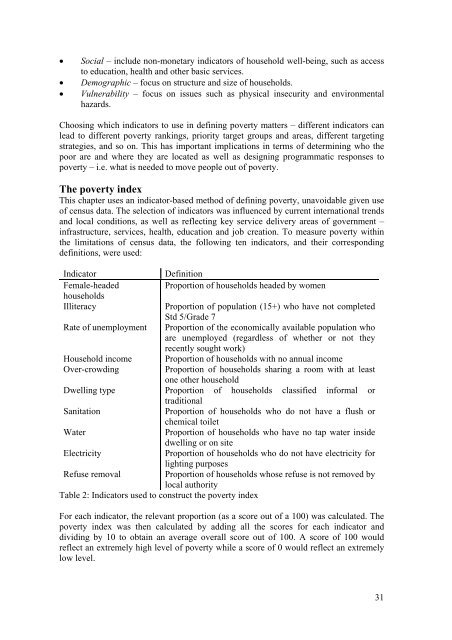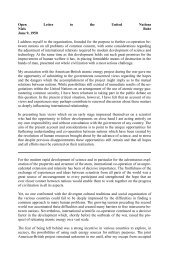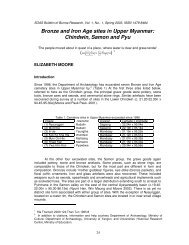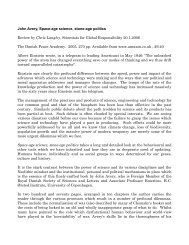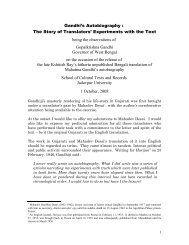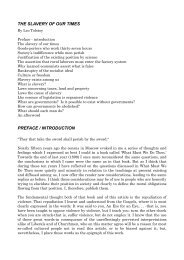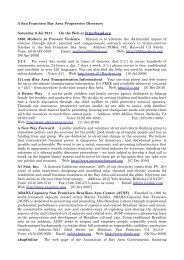History in the new South Africa: an introduction - Det danske ...
History in the new South Africa: an introduction - Det danske ...
History in the new South Africa: an introduction - Det danske ...
Create successful ePaper yourself
Turn your PDF publications into a flip-book with our unique Google optimized e-Paper software.
• Social – <strong>in</strong>clude non-monetary <strong>in</strong>dicators of household well-be<strong>in</strong>g, such as access<br />
to education, health <strong>an</strong>d o<strong>the</strong>r basic services.<br />
• Demographic – focus on structure <strong>an</strong>d size of households.<br />
• Vulnerability – focus on issues such as physical <strong>in</strong>security <strong>an</strong>d environmental<br />
hazards.<br />
Choos<strong>in</strong>g which <strong>in</strong>dicators to use <strong>in</strong> def<strong>in</strong><strong>in</strong>g poverty matters – different <strong>in</strong>dicators c<strong>an</strong><br />
lead to different poverty r<strong>an</strong>k<strong>in</strong>gs, priority target groups <strong>an</strong>d areas, different target<strong>in</strong>g<br />
strategies, <strong>an</strong>d so on. This has import<strong>an</strong>t implications <strong>in</strong> terms of determ<strong>in</strong><strong>in</strong>g who <strong>the</strong><br />
poor are <strong>an</strong>d where <strong>the</strong>y are located as well as design<strong>in</strong>g programmatic responses to<br />
poverty – i.e. what is needed to move people out of poverty.<br />
The poverty <strong>in</strong>dex<br />
This chapter uses <strong>an</strong> <strong>in</strong>dicator-based method of def<strong>in</strong><strong>in</strong>g poverty, unavoidable given use<br />
of census data. The selection of <strong>in</strong>dicators was <strong>in</strong>fluenced by current <strong>in</strong>ternational trends<br />
<strong>an</strong>d local conditions, as well as reflect<strong>in</strong>g key service delivery areas of government –<br />
<strong>in</strong>frastructure, services, health, education <strong>an</strong>d job creation. To measure poverty with<strong>in</strong><br />
<strong>the</strong> limitations of census data, <strong>the</strong> follow<strong>in</strong>g ten <strong>in</strong>dicators, <strong>an</strong>d <strong>the</strong>ir correspond<strong>in</strong>g<br />
def<strong>in</strong>itions, were used:<br />
Indicator Def<strong>in</strong>ition<br />
Female-headed<br />
households<br />
Proportion of households headed by women<br />
Illiteracy Proportion of population (15+) who have not completed<br />
Std 5/Grade 7<br />
Rate of unemployment Proportion of <strong>the</strong> economically available population who<br />
are unemployed (regardless of whe<strong>the</strong>r or not <strong>the</strong>y<br />
recently sought work)<br />
Household <strong>in</strong>come Proportion of households with no <strong>an</strong>nual <strong>in</strong>come<br />
Over-crowd<strong>in</strong>g Proportion of households shar<strong>in</strong>g a room with at least<br />
one o<strong>the</strong>r household<br />
Dwell<strong>in</strong>g type Proportion<br />
traditional<br />
of households classified <strong>in</strong>formal or<br />
S<strong>an</strong>itation Proportion of households who do not have a flush or<br />
chemical toilet<br />
Water Proportion of households who have no tap water <strong>in</strong>side<br />
dwell<strong>in</strong>g or on site<br />
Electricity Proportion of households who do not have electricity for<br />
light<strong>in</strong>g purposes<br />
Refuse removal Proportion of households whose refuse is not removed by<br />
local authority<br />
Table 2: Indicators used to construct <strong>the</strong> poverty <strong>in</strong>dex<br />
For each <strong>in</strong>dicator, <strong>the</strong> relev<strong>an</strong>t proportion (as a score out of a 100) was calculated. The<br />
poverty <strong>in</strong>dex was <strong>the</strong>n calculated by add<strong>in</strong>g all <strong>the</strong> scores for each <strong>in</strong>dicator <strong>an</strong>d<br />
divid<strong>in</strong>g by 10 to obta<strong>in</strong> <strong>an</strong> average overall score out of 100. A score of 100 would<br />
reflect <strong>an</strong> extremely high level of poverty while a score of 0 would reflect <strong>an</strong> extremely<br />
low level.<br />
31


